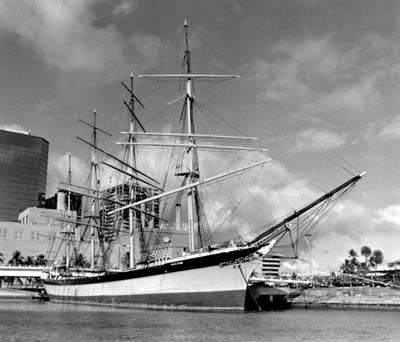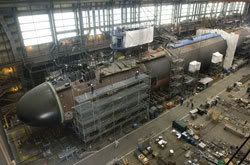This week's ship is one of unique status, the only sail-rigged oil tanker in existance, the
Falls of Clyde
 Stats
Stats from the
National Park Service:Launched: 1878
Retired: 1922 (as a hulk)
Length: 266.1 ft
Beam: 40.0 ft
Draught: 21.0 ft
Displacement: 1707 tons
Compliment: variable
Rig: Launched as a 4 masted ship rig, converted to bark in 1899Built in Glasgow, Scotland, in1878 as the launching of a steel hulled windjammer fleet for the Glasgow Falls Line, the
Falls of Clyde takes her name after the Scottish waterfall, as were the GFL's subsiquent ships. The
Falls of Clyde made her career for the first twenty years of her life transporting bulk cargo that was still economical for sailing ships to transport: wheat from American Pacific Coast, nitrates from Chile, as well as cement, jute, and iron. In 1898 she was sold, and homeported in San Francisco, where through legislation she acquired a US registry, allowing her to participate in the now domestic Hawaiian sugar trade (Hawaii beciming a US colony in 1898). From then until 1907, she participated in the Hawaiian trade, transporting general cargo and passengers from the American Pacific Coast to Hawaii, and returning laden with sugar.
In 1907, she was again sold to the Associated Oil Co. of California, for use in the Hawaiian trade. She was reconfigured with pumps and ten large tanks in her hold, and an open space on her top deck for barrels, and entered the oil trade, carrying approximately 19,000 barrels of oil per trip. She continued to make between 5 and 7 voyages to Hawaii a year until 1920, when she was again sold, and made two voyages carrying oil between the United States and Denmark. She made one final voyage under yet another owner, to Buenos Aires, before being laid up, and sold as a gasoline and oil storage hulk for 37 years in Ketchikan, Alaska.
In 1959, she was no longer used as a fuel hulk, and several times was nearly wrecked before she could be purchased for restoration as a museum ship. She was remasted and restored, and by 1970 was open to the public in much her original condition as a sailing oil tanker. Recently, however, funds have been lacking for her upkeep, and the
Falls of Clyde stands the
danger of sinking at dockside unless she receives substantial contributions.
Read more!

